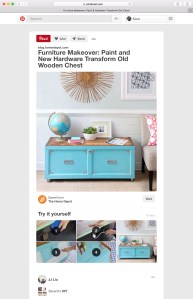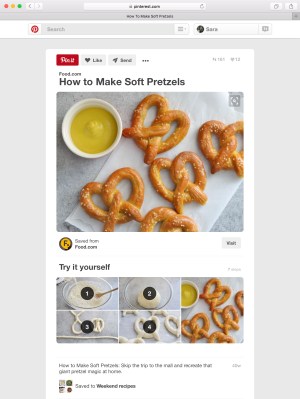As Pinterest continues to ramp up the parts of its business that generate revenues (namely advertising), it’s also expanding the free features that might entice users and brands to linger around for longer and engage more on it’s image-based social network for sharing ideas.
Today, Pinterest unveiled a new kind of dynamic Rich Pin called a How-to Pin, which provides step-by-step instructions for cooking, crafting, grooming and other activities shown off in the Pin. The How-to’s can be seen, followed and shared without ever leaving Pinterest.
How-to Pins are launching today in the U.S., France, UK and Germany on Android and web, with iOS to come in the future, the company said. Jason Costa, product manager for Pins, said that in all more than 25 brands and organizations are providing content for How-to’s free of charge (that is, it costs nothing for the brands to create these Pins in their own Custom Feeds).
Participating businesses include Brit & Co — which coincidentally acquired tech from a startup called Snapguide that pioneered this very feature and found a big audience on Pinterest for sharing its content. Among the others are Home Depot, Food.com, Martha Stewart, Cosmopolitan, and more.
But while individual users can repost these, they will not be able to create How-to Pins themselves, Costa said. The content will come up in your home feed if you follow the brand, as well as in a search on a specific topic or keyword, or by visiting a participating brand’s profile.
 Just as notable is how the How-tos will work: Costa says that while Pinners will be able to click through to hosting sites by clicking on the Visit button or on the image itself, what’s interesting is that “the step-by-step information on the Pin will help people take action without leaving Pinterest,” he said.
Just as notable is how the How-tos will work: Costa says that while Pinners will be able to click through to hosting sites by clicking on the Visit button or on the image itself, what’s interesting is that “the step-by-step information on the Pin will help people take action without leaving Pinterest,” he said.
This potentially moves Pinterest away from being as much of a referral site and more of a destination in and of itself, much like Twitter or Facebook when they launched their own hosted video to keep users on their own sites for longer.
To date, Pinterest — which counts more than 100 million monthly active users globally and 1 million businesses — has collectively racked up 50 billion Pins on more than 1 billion boards.
That data has been feeding into the products that Pinterest has been building to expand not just the amount of Pinning that a person does, but the time that users are spending on the site beyond glancing at the Pin itself.
Dynamic Rich Pins that lead to further actions underscore that strategy. They include app, movie, recipe, article, product and place Pins, which link through to previews of the wider content.
Costa says that article-based Rich Pins are currently the most popular of these, but there seems to be a lot of data that points to How-to Pins potentially becoming very popular: there are already more than 4 billion recipes and another 4 billion DIY Pins already on Pinterest, and 1 billion hair and beauty Pins, and another 500 million dedicated to health and fitness — all topics ripe for more explanation, or so Pinterest hopes.
(While Recipe Pins and How-to may feel like an overlap, Costa said that one is not replacing the other.)
As with the other Rich Pins, with the launch of How-to Pins, Pinterest is leaving the door open to add significantly more functionality into the Pin in the future. In the case of the How-to, Costa said that the ability to buy items featured in the steps won’t be there, “not at this time.”
This could imply that expanding Buyable Pins to work with Rich Pins could be something it has considered for a future rollout.
And while they are free to create today for big brands, you could imagine a tier for prosumer users, who look to Pinterest to build their own businesses, might be offered the ability to set up these pins as an ad unit.
(Indeed, trickling down to smaller businesses’ versions of products originally created for larger ones is a route that Pinterest has taken before, such as with its advertising management tool.)
Ramping up advertising and other commercial opportunities is likely an imperative for the site. Pinterest to date has raised $1.32 billion in funding. It reportedly projects some $3 billion in sales by 2018, although in 2015 it generated only about $100 million from advertising, currently its main source of revenue.
